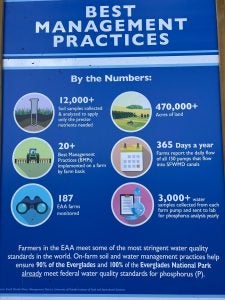It’s not uncommon for agriculture to get negative headlines in the media. In fact, it’s not hard for it to happen to anyone, specifically in the field of science communication.
Science is hard. It’s complicated, and there are many gray areas. And as someone who’s new to Florida, I wanted to dig into just how much of the fearmongering media headlines hold merit in this region, especially when those headlines point the fingers at farmers. Red tide? Lake Okeechobee? Is “big sugar” or “big dairy” really to blame? What are the facts vs. the myths? And is the water quality really as bad as they claim in South Florida?
Luckily, there is some really great research coming out of the region in regards to soil health, water quality, best management practices, and environmental protection overall.
“Red tide” — the name given to out-of-control algae growth along coastlines — actually pre-dates farmers in the area, and according government data, there is no evidence to support that agriculture is the culprit for red tide. It’s naturally occurring and doesn’t originate on farms. For more information on this, check out research from experts at Mote Marine Laboratory.
Sometimes it’s argued that water from South Florida sugar farms near Clewiston is damaging to Lake Okeechobee, which has been theorized as a source of red tied. But that’s not even possible considering that water flows south, not north. A majority of Lake O’s pollution comes from the Orlando area, where Disney and so many other industries that are north of the lake operate.
You can scroll through the Instagram images below to see breakdowns of a lot of this information:
View this post on Instagram
The Everglades Agricultural Area, an area of South Florida farmland more than 1,100 square miles in size, is a delicate ecosystem no doubt, which is why the Everglades Forever Act started in 1994. Farmers have reduced phosphorus by 55 percent on average each year since these programs came in to place — just one example of improving the environment. Additional programs for farmers include best management practices (BMPs) like the “4 Rs” of nutrient stewardship: the right source, right rate, right time, right place.
Newer technology and slow release fertilizers have also helped reduce and improve nutrient stewardship in the fertilizer application realm.

There are a ton of regulations put on farms to protect Florida water, and they’re on a scored points system with incentives to do the right thing. Hundreds of thousands of acres with tens of thousands of collected samples, monitored 365 days a year… water is serious business here.
Farmers also do GPS land leveling to prevent erosion and do record keeping of what they’re using when and where. Fertilizer and water pump use are public record and can be audited. Other industry and consumer use are not regulated whereas on farm record keeping is taken very seriously.

The media loves to sell fearmongering headlines as usual. But if you dig deeper with the experts, you learn that a lot of negative press within agriculture is unwarranted. Water is complicated, and there are currently 67 federally funded projects in the works in South Florida alone to balance competing interests and help the environment. Florida is home to hundreds of millions of residents and tourists (most of which are near sea level and they all flush the toilet!), yet it’s easy to put a target on farmers’ backs because a majority of people in cities don’t really realized just how strict regulations are for them.
And, of course, it also boils down to politics. Developers want this land, and ag doesn’t want to give it up. It’s complicated with many gray areas, but I highly recommend the resources listed below and ask questions of them! They’re an open book eager to share their story.
- South Florida Water Management District
- U.S. Sugar
- Lake Okeechobee Business Alliance
- University of Florida Institute of Food and Agricultural Sciences
Michelle Miller, the Farm Babe, is a farmer, public speaker, and writer who has worked for years with row crops, beef cattle, and sheep. She believes education is key in bridging the gap between farmers and consumers.



